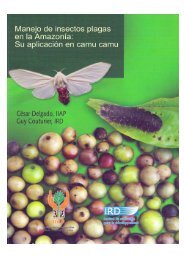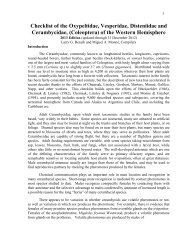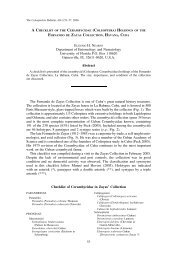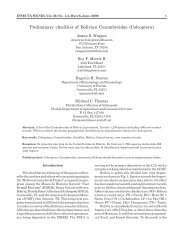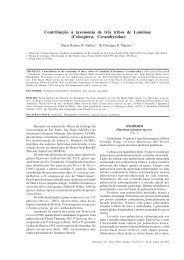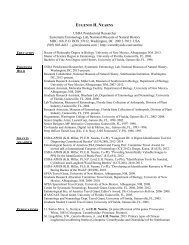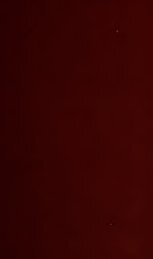You also want an ePaper? Increase the reach of your titles
YUMPU automatically turns print PDFs into web optimized ePapers that Google loves.
LAWRENCE S. DILLON <strong>AND</strong> ELIZABETH S. DILLON 113<br />
Lnmpedusa seniculus Bates<br />
PLATE V, FIGURE 9.<br />
HypseUnnus senicu1m Bates, Ann. Nat. Hist. (3), XVI, 1865, p. 167.<br />
Hypsimrnl seniculus Bates, loco cit., p. 170.<br />
Seniculus is distinctly fulvous pubescent j the elytra are distinctly<br />
maculate on apical third with ocbraceous j and the tarsal<br />
claw segment is paler than others, dark only at extreme tip.<br />
FEMALE. Elongate-ovate, rather robust, convex above; dark reddish-brown,<br />
covered with grayish tLud pale fulvous pubescence. Head and pronotwn mottled<br />
with brown pubescence. Elyt-ra with the pale fulvous pubescence more or less condensed<br />
here and there, especially along suture and apically, to form a number of in<br />
distinct maculae. Body beneath, legs, and antCllOae reddish-brown, cntirely covered<br />
Ivith pale grayish-fulvous pubescence, finely mottled with brown; tarst:\l claw seg<br />
ment paler than others, d:trk only at. extreme tip; :tntennal segments from third<br />
tinged with brown at apices.<br />
Head minutciy alutaceous, with a median impre&ed line from occiput to near<br />
cJypeus; front concave between antennal tubercles, elongate, slightly n:trrower<br />
above, minutely, densely punetate, without larger puncturcs; genae transverse,<br />
minuteJy alutaceous; eye with lower lobe broadly oblong, large, nearly three hmes<br />
the height of gena, a little wider above than below; antennal tubercles r:tthcr robust,<br />
slightly prominent, widely separated, at apex with a very short, acute tooth. Pro<br />
notum transverse, about one-half again as wide as long, sides slightly narrower at<br />
apeX thnn at base, unarmed, exp!1nded from behind middle, theli llarrowed apically;<br />
apical transverse sulcus obsolete, basal one distinct, straight, connecting with the<br />
short lateral oblique ones; disk entircly tumid, almost altogether smooth, with !1<br />
tubercle at middle and one each side feebly elevated, obsolete. Scutellum slightly<br />
transverse; sides broodly rounded ; aJlC.'" more strongly so, slightly impressed at<br />
middle. Elytra indistinctly narrowed to apices, which are separately rounded ; disk<br />
at base coarsely, not densely punctate, behind middle punctures finer, from apical<br />
quarter obsolete; humeri feebly prominent, anterior margin curved, :tugle without a<br />
tubercle, but here begins a long, smooth carina whlch extends posteriorly to slightly<br />
beyond middle. Prosternum suddenly widened before middle, then gr!1dually ex<br />
p!1nded t.o basco Procoxae with a low obtuse tubercle anteriorly; femora robust,<br />
clavate, metafemora more slender, profemom not rugose. Fifth eternite one-half<br />
longer than fourth, ape;..: feebly retuse. Antennae slightly longer th:tn body, sparsely<br />
fimbriate beneath to apex; $Cape slender, feebly clavate from b:t.se, not rugose;<br />
t,bird segment one-fourth longer than first, slightly sinuous; fourth about as long as<br />
first, rest gradually shorter; eleventh a little longer than tenth, tapering.<br />
LENOTH 12 mm.; width 4.5 mm.<br />
Type looality.-Ega, Brazil.<br />
Distribution.-Amazon region southward to Bolivia.<br />
BoLIVIA: 2; St. Helena, 1921 j (W. M. Mann); [U.s.N.M.].



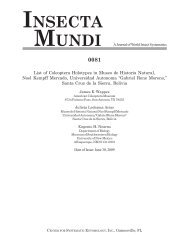
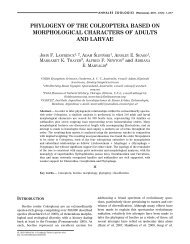


![Coleoptera. Vol. I. [Longicornia. Part I.]](https://img.yumpu.com/41202793/1/180x260/coleoptera-vol-i-longicornia-part-i.jpg?quality=85)
